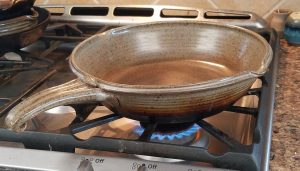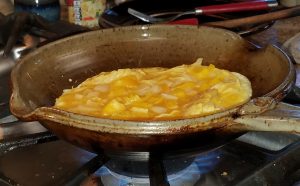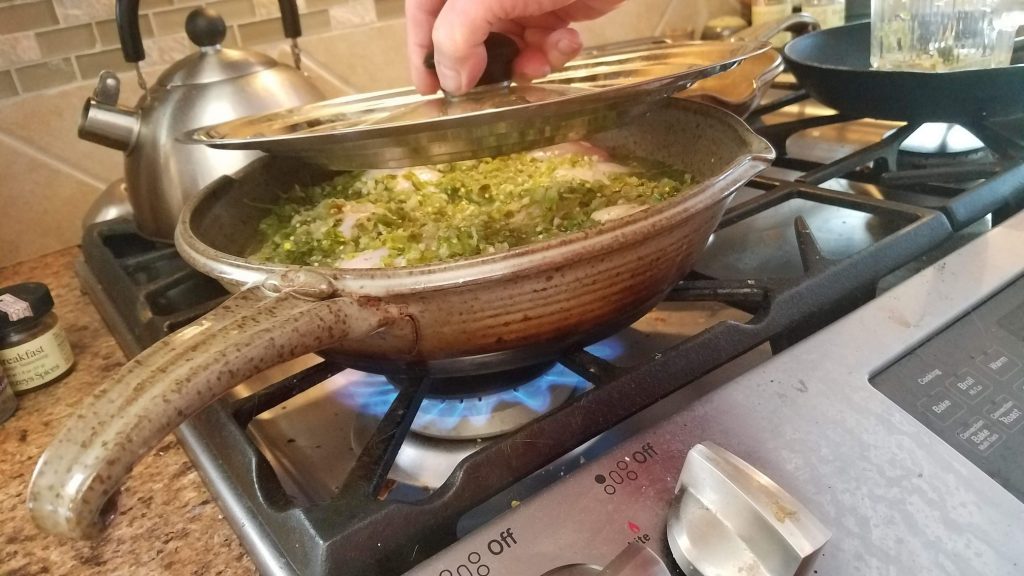FLAMEWARE – CLAYPOT STOVETOP COOKING
FLAMWARE CLAY-POT STOVETOP COOKING
Handmade, Ceramic Stovetop Cookware.
Handmade For for direct flame, Grill
and Oven use.
Flameware – ClayPot Stovetop cooking is different from any way you’ve cooked before. What makes it different?
Flameware Pots are pure ceramic, not ceramic coated metal. Ceramic cooks differently because it is an insulator, not a conductor like metal. We’ll get to specifics later. Take a minute and look at our article “The Basics of All-Ceramic Cookware”.
CLAY-POT STOVE-TOP COOKING
WITHOUT THE BOTHER OF EARTHENWARE
Flameware ClayPot Stovetop cooking… Flameware is different from the low-fire earthenware pots from Europe (especially Mediterranean) and Mexico. While many of those, somewhat porous, pots will take direct flame, you must be gentle. Also, they are unique in that they absorb and retain some of the moisture, fats and flavors of their contents. Paula Wolfert explains this in her wonderful book “Mediterranean Claypot Cooking”.
THE HISTORY OF CERAMIC STOVETOP POTTERY
Ceramic has been used for cooking for millennia. Indeed cooking (combining various ingredients and heating) was made possible by the discovery of flameproof clay materials. Metal, much more recently, kind of took over for cookware because it isn’t breakable.
Tom was introduced to Flameware – ClayPot Stovetop cooking through a request from Paula Wolfert to make flameware clay pots for stovetop cooking. (See “Flameware as I have lived it”). First were skillets and saucepans. Then a Dutch Oven that could be used for everything from a bean pot, to a soup or stew kettle, even up to doing a Sunday roast, but on the stovetop…and all in clay.
WHAT ARE THE DIFFERENCES BETWEEN
FLAMEWARE AND EARTHENWARE?
The first difference you run into between Flameware clay pot stovetop cookware and earthenware is that earthenware generally must be soaked, with water or have milk cooked in it to seal it. Because earthenware is fired at much lower temperatures, it does not vitrify, or form a glass-like body. So it is porous and can soak up liquids and fats from cooking.
THEN THERE”S THE HEAT
Earthenware was generally first used over open fires or charcoal or wood fired stoves. While earthenware easily withstands this, it can soak up heat from a direct flame, and it must be done gently.
Flameware ClayPot Stovetop Cookware is high fired to around 2450 degF. This completely vitrifies the clay body and melts a glaze into the surface.
The downside of this is that the porous earthenware will soak up liquids, fats and flavoring from the foods, and carry this forward into future cooking, one of the main reasons cooks say that an earthenware pot keeps getting better with use.
With Flameware – ClayPot Stovetop Cooking you can literally go from a freezer or refrigerator to the stove at full heat. Fridge to stove can be handy for reheating leftovers.
CLEANUP IS EASIER WITH FLAMEWARE
Because the clay is glazed and fully fired, Flameware clay pot stovetop cookware can be washed by hand or dishwasher. With earthenware, it must be hand-washed avoiding soaps that can put flavor into the porous pot.
Generally, with earthenware, it is recommended to be sure the pot is fully dried before storing. Because some fats and food residue may remain in the pot, a damp pot is subject to mold. Not necessarily dangerous, but it must be cleaned before use.

